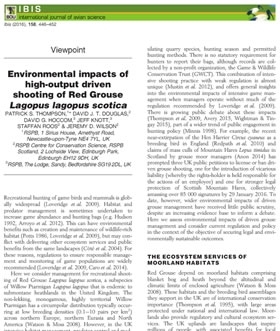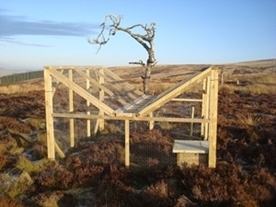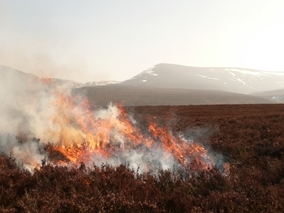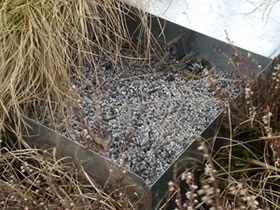Key points
- A paper published in Ibis by RSPB authors last year stated that the management performed on moorland to maximize red grouse numbers can have damaging impacts on the environment.
- A response paper in the same journal by GWCT authors states that, while the GWCT would agree with the evidence given, the paper did not present all of the relevant scientific evidence including that which puts forward an opposing view.
Background
 In April last year, six authors from the RSPB published a paper in the scientific journal Ibis, outlining their views on driven grouse shooting, and the impacts that grouse moor management has on the moorland environment. This paper, led by Dr Patrick Thompson, argues that these management techniques can have a damaging effect. The article is called a “viewpoint” because it represents the authors’ opinions, based on some of their own work and some from the published literature.
In April last year, six authors from the RSPB published a paper in the scientific journal Ibis, outlining their views on driven grouse shooting, and the impacts that grouse moor management has on the moorland environment. This paper, led by Dr Patrick Thompson, argues that these management techniques can have a damaging effect. The article is called a “viewpoint” because it represents the authors’ opinions, based on some of their own work and some from the published literature.
The GWCT paper, led by Prof Nick Sotherton, felt that the article omitted some of the scientific evidence relating to moorland management, and published a response “viewpoint” including much of this additional information. While it is difficult to include all the published evidence on the impacts of grouse moor management, both positive and negative (often while reviews are being published, more evidence appears in the scientific journals), the GWCT authors thought that some attempt should be made to supply the evidence omitted by the RSPB.
A summary of grouse moor management techniques is below, followed by the views on both sides presented by Thompson and Sotherton.
Grouse moor management
Grouse moors are managed to improve the habitat for red grouse, to increase their numbers and therefore enable the surplus to be shot. The techniques used to improve moorland for grouse are:
1. Predator control – gamekeepers control the number of predators that can prey on grouse, for example the fox, stoat and carrion crow.
2. Managed heather burning – This technique is performed to stop heather becoming old and woody, promote growth of young shoots and therefore provide food for red grouse. It aims to give a pattern of different ages and heights of heather across the moor, providing areas for feeding, nesting, and taking cover. To comply with best practice guidelines, burning should be performed as controlled, rotational burns in small patches on a suitable rotation for the habitat. The term “moorland” in fact covers a range of underlying environments, which can broadly be divided into heathland or blanket bog, and appropriate management can differ between these two. Heather is generally slower growing on deep peat, hence blanket bog should be burned on longer rotations and using cool burns to avoid damage to the sensitive Sphagnum mosses or setting fire to the underlying peat.
3. Veterinary care
a. Grouse can suffer from a parasitic gut worm that causes a disease called strongylosis. If birds on a moor are thought to be infected, or at risk of infection, the worm can be treated by providing grit coated in an anti-worm medication.
b. Where sheep ticks are found on moorland, some owners take measures to reduce their number because ticks also parasitize red grouse chicks and can transmit an illness called Louping Ill Virus (LIV). In lab trials LIV can kill up to 85% of infected grouse chicks. They do this by applying treatments to the sheep that graze the moor, which then kill ticks that feed on those sheep. Sheep can also be given vaccines to protect against the virus itself. These measures can reduce viral prevalence in sheep, with knock-on reductions in grouse. Ticks also feed on mountain hares and deer, which helps maintain their numbers thus probably reducing the effectiveness of treatments applied to sheep. In such circumstances, these alternative hosts are often culled.
1. Predator control
 Thompson’s view:
Thompson’s view:
- Predator control can be helpful for other threatened breeding birds on moorland, as well as grouse.
- But gamekeepers do not control only those species that are legally permitted, they also illegally kill other predator species, particularly birds of prey.
Sotherton’s view:
- Moorland management for grouse shooting, including predator control, is a conservation success story that needs more emphasis: the improved breeding success and increasing abundance of breeding pairs of lapwing, curlew and golden plover, all species of conservation concern.
- The illegal killing of protected species has had an effect on some bird of prey populations, for instance hen harriers as well as eagles, red kites, buzzards. Grouse shooting cannot be thought of as environmentally sustainable if it relies on this behaviour.
- However, a study carried out at Langholm Moor in southwest Scotland showed that, in the absence of persecution, harriers benefited from the control of other predators by gamekeepers, with higher numbers and better breeding success.
Additional evidence in Sotherton et al:
Baines & Richardson paper, 2013: When predator control was performed, hen harriers at Langholm Moor successfully raised twice as many chicks as when it was not performed on the same land.
2. Managed heather burning
 Thompson’s view:
Thompson’s view:
- Managed burning can help maintain heather moorland, and this is a good habitat for some birds of conservation concern such as the curlew and golden plover. However, burning reduces nesting cover for some species that prefer deep heather, for example hen harriers and short eared owls. Maintenance of heather moorland by burning also makes the area less favourable for species which prefer grassy moorland, and prevents transition to scrub and the biodiversity associated with that habitat.
- Burning is becoming more frequent, and is happening in areas which should not be burnt.
- They are concerned about the effect of burning on certain peat-forming moss species, the carbon cycle, and water.
Sotherton’s view:
- Managed burning helps to maintain important heather habitats that are rare and disappearing around the world, and are of international conservation importance.
- A recent study in the Peak District showed that managed burning on that study moor had been performed to best-practice standards of burn size, frequency and overall area burned.
- The scientific evidence looking at the effect of burning on carbon cycles, water flow and the reduction of wildfires is not clear, and often contradictory. More research is required before long-established techniques with known benefits are markedly altered or even condemned altogether.
- There is a possible role of managed burning in helping to prevent wildfire, which is not acknowledged by Thompson.
Additional evidence in Sotherton et al:
Allen paper, 2016: Used aerial photographs to examine a moor in the Peak District, and showed that burning practices followed best-practice guidelines with respect to burn size, area burned and frequency of burning. Sotherton et al recognise that this study is limited to one site, which may not necessarily be reflective of other sites, but still provides important evidence.
Allen paper, 2013: Managed burning can reduce carbon loss caused by wildfire by significant amounts, with the most appropriate rotational burn cycle length determined by the likely interval between wildfires. Where wildfires could be expected every 50 to 100 years, short (8-year) rotational burn cycles could reduce carbon loss the most. Where wildfires were likely every 200 years, carbon loss was minimised by 25-year rotational burn cycles.
3. Veterinary care
 Thompson’s view:
Thompson’s view:
- The evidence that culling of mountain hares helps red grouse populations by reducing tick abundance and the prevalence of louping-ill virus is weak.
- Medicated grit administration to treat gut worms happens routinely, rather than when infection is proven (as per best-practice guidelines), which could lead to effects on the environment, particularly in water. This raises wider concerns about regulation of veterinary medicines.
- Thompson highlights the possible problem of a disease called cryptosporidiosis, which has been reported in red grouse for the first time in 2010, and appears to be rising.
Sotherton’s view:
- Sotherton agrees that evidence for the role of mountain hare culling in red grouse disease management is weak, and more is urgently needed.
- Ticks can feed on other birds such as curlew, lapwing and black grouse, and at high levels can reduce their body condition, and in some cases, their survival. Sotherton points out that as tick numbers are increasing in the UK, this should be a concern for conservationists, and also the public, as ticks can transmit Lyme disease to humans.
- The treatment used in medicated grit for red grouse has passed environmental tests for veterinary medications. If genuine concerns remain about its use and environmental impact, more work is needed to address these.
Additional evidence in Sotherton et al:
Newborn paper, 2009: Ticks parasitize chicks of other ground-nesting birds including curlew and lapwing.
What does this mean?
The debate surrounding driven grouse shooting is fuelled partly by science, partly by opinion and severely hindered by biased reporting. These two papers present different views on the subject, with different interpretations of some of the evidence. In many areas of debate, stronger evidence would be helpful.
Read the original abstract
Sotherton, N.W., Baines, D., & Aebischer, N.J. (2017). An alternative view of moorland management for Red Grouse Lagopus lagopus scotica. Ibis, 159: 693-698.